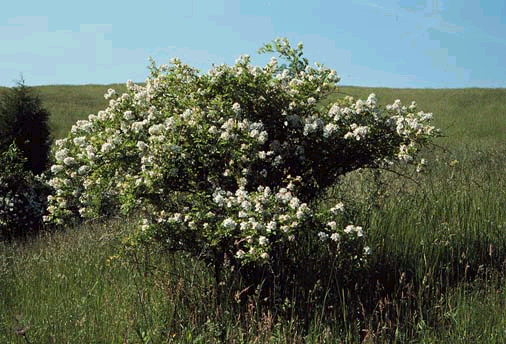
When out digging the dogs, it is not uncommon to find a sette under a thick break of multiflora rose, with perhaps a few broken strands of barbed wire snaking along the ground right next to the hole.
In that little picture is a story.
Multiflora rose originated in Japan and was imported to Europe around 1862 to serve as a root stock for "rambling" roses.
Rambling roses became a craze with the creation of "Turners Crimson Rambler" in 1893, and this craze lasted for about 30 years until the modern, repeat blooming, large-flowered climbing roses were created.
The first multiflora roses to "go native" in the U.S. were rambling roses that originate during the rose craze of the very early 20th Century. In truth, these feral roses were not much of a problem.
The problem started in the 1930s and extended into the early 1960s as the U.S. Department of Agriculture and various State highway departments promoted multiflora rose as a "cure-all" for many public and farm landscaping problems.
In truth, multiflora rose did seem to be a good solution for a lot of difficult areas. Multiflora was cheap, easy to propagate from cuttings, and was rampant with vigor. Long, arching and pliable canes with thorns were perfect for shielding car lights from oncoming traffic, discouraging humans from entering fields or crossing roadways, and keeping cattle out of riparian areas.
Rose roots seemed to thrive in a large variety of soils, tolerated both drought and wet reasonably well, and they did a commendable job of stabilizing creek banks and slowing erosion on slopes. Rose hips were also eaten by a wide variety of song birds and animals, providing a needed food source in winter.
The U.S. Department of Agriculture and its various state analogues vigorously promoted multiflora rose as a low-cost alternative to barbed wire. Barbed wire had made its way East several generations earlier after first being established in the West.
Unlike western wire, which was typically strung from post to post, eastern wire was often strung from existing trees around the edges of woods, creeks and fields. In time, these the trees grew and absorbed the wire into their trunk. Embedded wire was difficult to remove and made the trees worthless as timber since wire and nails wrecked commercial saw blades and had the potential of turning a chainsaw into a lethal weapon.
Like so many good ideas, the promotion of multiflora rose has unintended consequences. A mature multiflora rose bush can put out half a million seeds a year, and these seeds are easily spread by birds and can live in the soil for 10 years or more.
Farmers found that getting rid of a rose hedge required riping it out with a bulldozer and then plowing and mowing the areas multiple times a year for several years in order to destroy the existing root and seed stock in the soil.
The good news with multiflora rose is that has truly been a boon to wildlife. Rose hips are consumed by robins, grouse, cedar wax wings, pheasants, wild turkeys, fox, chipmunks, white-tailed deer, possums, coyotes, black bears, beavers, rabbits and raccoons. Thick rose breaks provide shelter for deer and bear, as well as groundhogs, possums, fox, rabbits, and raccoons. Rose hedges along stream banks have worked to keep cattle and horses out of riparian areas, resulting in less erosion, cleaner water, and excellent denning sites for raccoons.
Next time you find yourself digging a hole in the middle of a multiflora rose bush with broken barbed wire snaking along the ground, remember that these stabbing obstacles are, in a very real sense, a significant player in the vigorous return of wildlife we see in in the Eastern U.S. today. Though they may be the enemy of the moment, they are the long-term friends of terrier work.
No comments:
Post a Comment